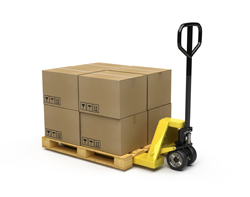Reinventing the hand pallet truck
High costs of materials, machinery and products in the materials handling sector has led to a significant rise in importing both raw and ready-made materials and products from Asia. One way to combat this trend is to create innovative and high-performance materials and plastics in order to build equipment and products that differentiate themselves from low-cost–labour products from Asia. The HPT represents an excellent example of a product that could be manufactured in the EU using quality plastic-type materials, offering important advantages over cheaper imports. The EU-funded project ECOPAT(opens in new window) used novel techno-plastics and designed an HPT that could upgrade the performance of the handling sector and increase its efficiency. Taking into consideration the intricate complexity of this deceivingly simple-looking trolley used to lift goods safely, ECOPAT studied how to exploit lighter polymeric materials in HPT production for improved operation. It considered self-reinforced plastics featuring a fibre-reinforced polymeric matrix that offer 3–5 times the strength and stiffness of more traditional polymers. The project team also worked to enhance the HPT's lightness, life cycle and environmental impact, in addition to improving health and safety in the workplace. To achieve these aims, the project partners, who represent a complete supply chain, began by investigating polyolefins, polyamides and polyesters suitable for the considered application. They also studied considerations such as payload capacity, dimensional constraints, weight, noise, structure, thermal properties and safety. After intensive experimentation with different materials using novel techniques (e.g. induction heating applied to compression and injection moulding), the team developed an HPT prototype. It was successfully tested in real-world conditions for an average weight of 700–800 kg, demonstrating its lightweight properties, accessibility, manoeuvrability and ease of use. These positive results were disseminated to stakeholders through different media and events, showcasing a technology that could easily be exploited and commercialised. The new HPT model is expected to capture 5.6 % of the worldwide HPT market by the third year following commercialisation. ECOPAT represents an excellent example of how differentiating products on the basis of performance and quality will help carve a valuable niche market for European products.







